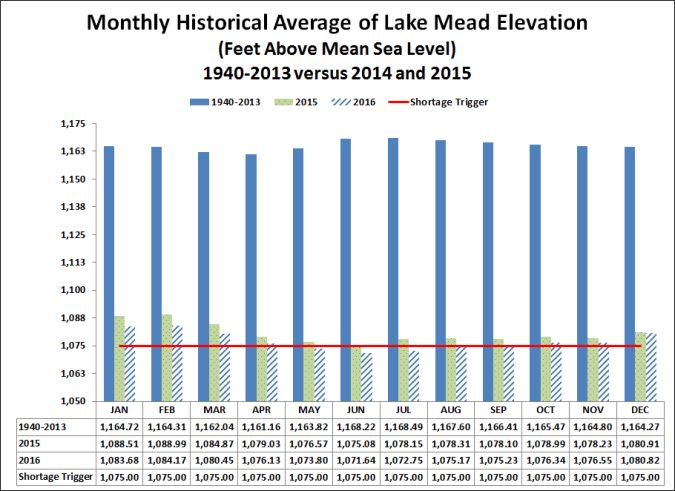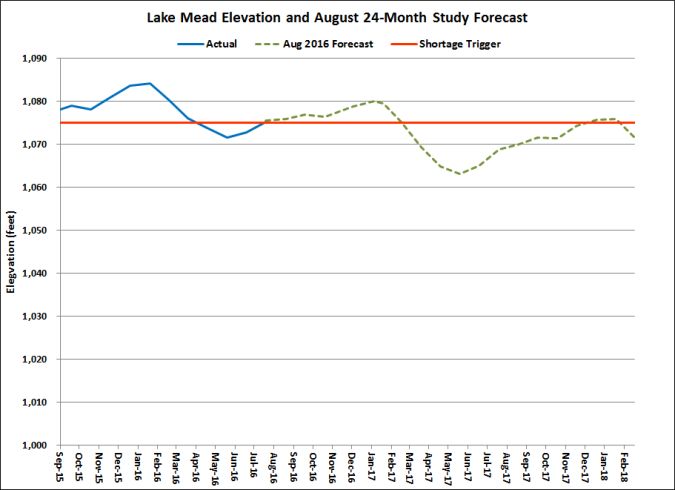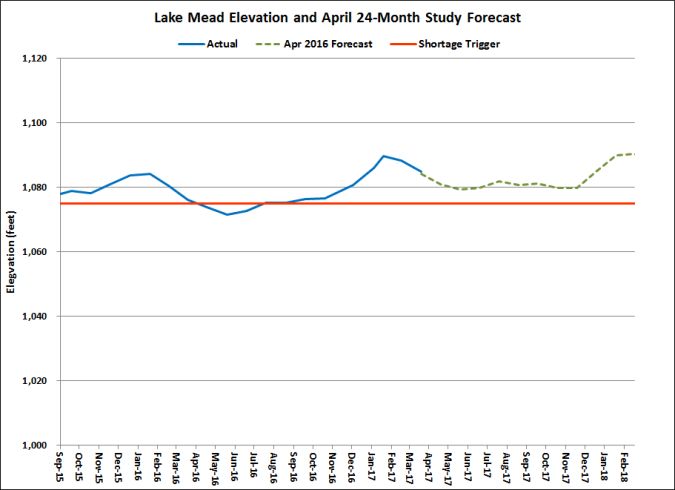High precipitation this winter has significantly reduced the chances of a Lower Basin shortage in the next 4 years.
2016 saw historic lows in the elevation of Lake Mead. Elevations dropped below 1,075 feet in May, June and July—with a low of 1,071.64 feet in June (see chart). While there has been a trend of progressively lower “highs” in successive winter elevations and lower “lows” in successive summer elevations over the last several years, the degree of the drop increased concern about the possibility of a shortage declaration for 2017. Under the 2007 Interim Guidelines, a shortage is declared if the Bureau of Reclamation’s (“Reclamation”) August 24-Month Study projects that Lake Mead’s elevation will be less than 1,075 feet the following January.

In its August 2016 24-Month Study, Reclamation projected that the January 2017 elevation of Lake Mead would be 1,080.02 feet—about 5 feet ABOVE the level for a shortage declaration (see chart). While there would be no shortage for 2017, Colorado River Simulation System (“CRSS”) modeling projected a 48% chance of a shortage declaration for 2018. The subsequent three years saw even greater chances of shortage, with a 60% chance of any level of shortage in 2019 and 2020 and a 56% chance in 2021.

Precipitation forecasts also bore bad news for the Colorado River Basin. At the outset of the precipitation season, the three-month outlook forecasted equal chances for above-normal, below-normal or normal precipitation in the Upper Basin and below-normal precipitation in the Lower Basin. By late November, forecasts showed above-normal precipitation in the Green River watershed, but expectations otherwise remained the same.
Enter El Niño.
The movement of air moisture from the Pacific Ocean brought vital precipitation to the Colorado River Basin. Precipitation levels throughout the Basin ranged from 150% to 300% of average in December and 110% to 500% of average in January. The elevation of Lake Mead increased from 1,076.55 feet in November to 1,086.08 feet in January—more than 6 feet above the level projected in August. Conditions continued to improve through February, and the elevation of Lake Mead increased to 1,089.78 feet.
Modeling from Reclamation’s Mid-Term Probabilistic Operations Model (“MTOM”) and CRSS in January showed a significant drop in the chances of a shortage declaration. There is now a 34% chance of a shortage in 2018, and the April 24-Month Study projects an elevation of 1,085.07 feet for January 2018 (see chart). The subsequent three years have even lower chances of a shortage, with projections showing a 30% chance of any level of shortage in 2019, a 29% chance in 2020 and a 33% chance in 2021.

The drop in the chances of a shortage declaration are tied to improved inflows into Lake Powell based on the mid-January inflow forecasts. They do not consider planned but not-yet-realized efforts to further bolster Lake Mead’s elevation, such as Central Arizona Project’s conservation plans or Metropolitan Water District’s plans to create Intentionally Created Surplus (“ICS”).
While Lake Mead’s elevation dropped about 1.5 feet to 1,088.26 feet, and warm, dry conditions eliminated some of the snowpack in March, hydrology remains favorable. The snow water equivalent (“SWE”) measured on March 27, 2017 was at 135% of the long-term average for the date and 128% of the long-term average for the season. Unregulated inflows into Lake Powell have also been well-above average. In March the inflows totaled 1.110 MAF (167% of the long-term average), and April inflows are forecasted at 1.6 MAF (152% of the long-term average). The April–July forecast projects that unregulated inflows will be 130% of the long-term average for the season.
While improved hydrologic conditions reduce the chances of a near-term shortage declaration, the Lower Basin is over-appropriated. Conditions will not turn around without addressing the 1.2 MAF per year structural deficit.
Written by Marta L. Weismann
You must be logged in to post a comment.